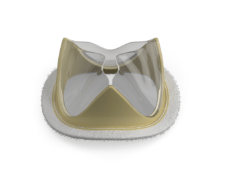According to a study published in the European Journal of Heart Failure, severe aortic stenosis patients with low-mean gradient and reduced left ventricular ejection fraction (LVEF) have worse outcomes after transcatheter aortic valve implantation (TAVI) than patients with preserved LVEF and high-mean gradient.
Michael Gotzmann, Berufsgenossenschaftliche, Kliniken Bergmannsheil, Cardiology and Angiology, Ruhr-University Bochum, Bochum, Germany, and others wrote that beyond the classic definition of severe aortic stenosis (aortic valve area <1cm2, aortic mean gradient >40mmHg, or peak aortic velocity >4m/s), different clinical entities of aortic stenosis have been described to account for patients who have a low cardiac output and, thus, may have lower mean gradient and peak aortic velocity. Gotzmann et al stated these entities were: aortic stenosis with reduced LVEF and low-mean gradient reduced LVEF and high-mean gradient; preserved LVEF and low-mean gradient; and preserved LVEF with high-mean gradient. The authors reported that “each entity of aortic stenosis is characterised by different clinical presentation and prognosis.”
They added that, as a “considerable proportion” of patients die within two years of undergoing TAVI, the aim of their study was to “evaluate the prognostic impact of different LVEF-gradient patterns on outcome as well as the changes in left ventricular geometry and function in different entities of aortic stenosis after TAVI”.
Gotzmann et al reviewed 202 consecutive patients who received TAVI at their centre between March 2008 and February 2011 and subdivided them into groups: preserved LVEF and high-mean gradient (group one, 86); preserved LVEF and low-mean gradient (group two, 27); reduced LVEF and high-mean gradient (group three, 45); and reduced LVEF and low-mean gradient (group four, 44). Echocardiograms were performed seven days prior to the TAVI procedure and 12 months afterwards. Gotzmann et al reported that the primary endpoint was “death from any cause within the first year after TAVI” and that the secondary endpoint was “cardiovascular death within the first year”.
All-cause mortality was significantly higher in patients with reduced LVEF (including those with low-mean gradient and those with high-mean gradient) compared with patients with preserved LVEF (32% vs. 18%; p=0.004, respectively), and patients with low-mean gradient had poorer outcomes at one year than those with high-mean gradient (all-cause mortality 32% vs. 15%, respectively, p=0.013). Gotzmann et al noted: “Clinical outcome was best for patients in group one, whereas all-cause mortality increased in groups two and four (14%, 22%, 27%, and 39%, respectively, p=0.0007).” However in patients with reduced LVEF who were still alive one year after undergoing TAVI, left ventricular diameters and volumes were reduced and LVEF was improved with no significant difference in improvement between those with low-mean gradient and those with high-mean gradient.
The authors stated that the main finding of their study was that “one year after TAVI all-cause mortality as well as cardiovascular mortality was lowest in patients with preserved LVEF/high gradient aortic stenosis, intermediate in preserved LVEF/low gradient aortic stenosis and reduced LVEF/high gradient aortic stenosis, and highest in reduced LVEF/low gradient aortic stenosis.”
In an accompanying editorial, HW van der Werf (Unviersity Medical Center Groningen, The Netherlands) and others wrote that the findings of Gotzmann et al indicate that there is a “clear need for more stringent selection” when choosing patients to undergo TAVI. However, they added that rejecting patients with reduced LVEF and low-median gradient aortic stenosis, because of the high mortality in this group seen in Gotzmann et al’ study, meant “withholding a reasonable amount of people an important survival benefit and improvement of quality of life.” Van der Werf et al commented: “To come to a better selection, the focus must lie on the risk factors of this group of patients.”













